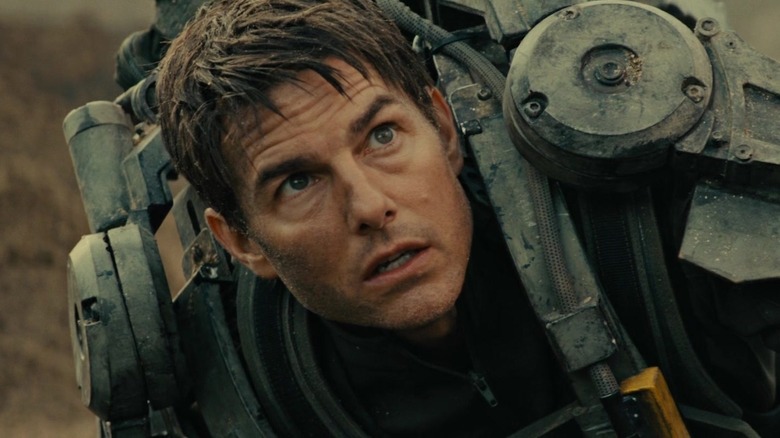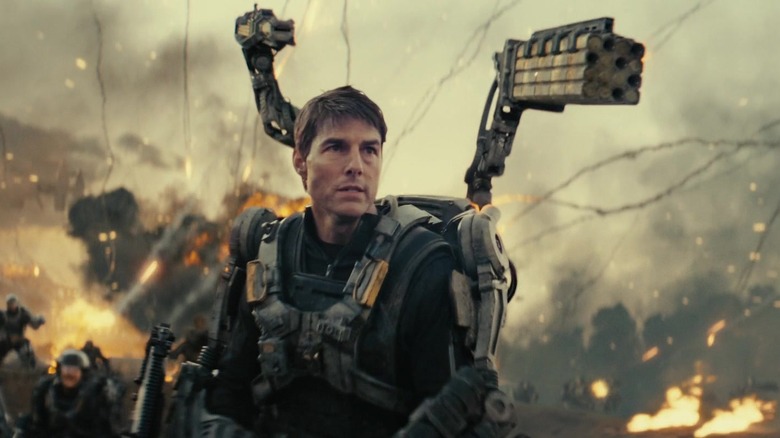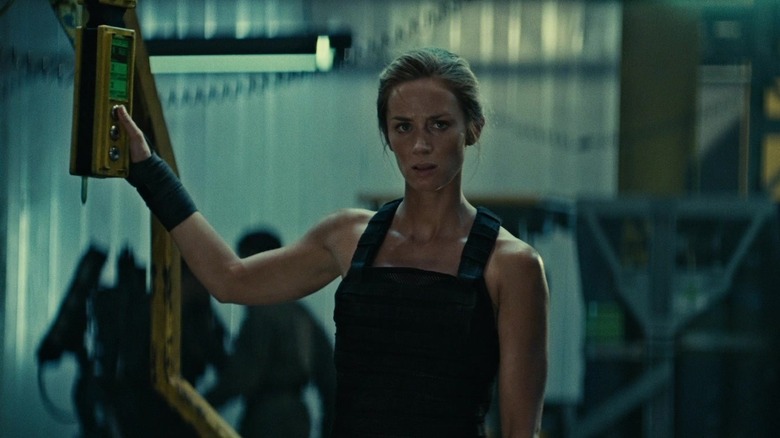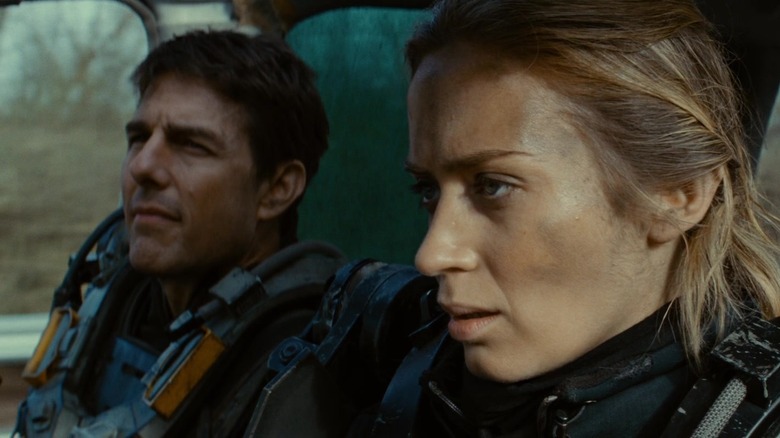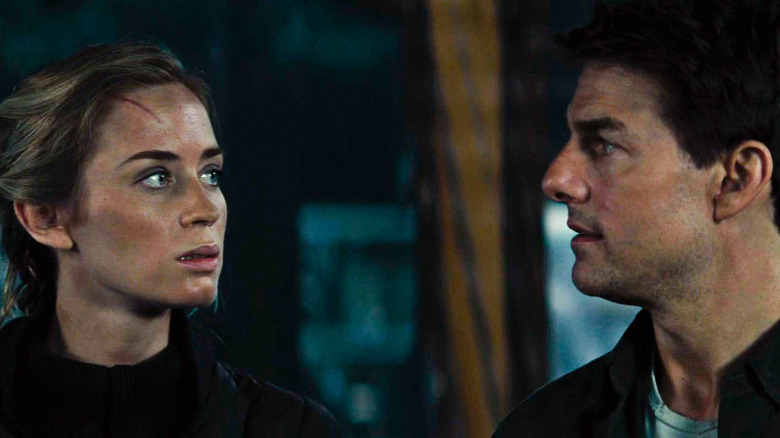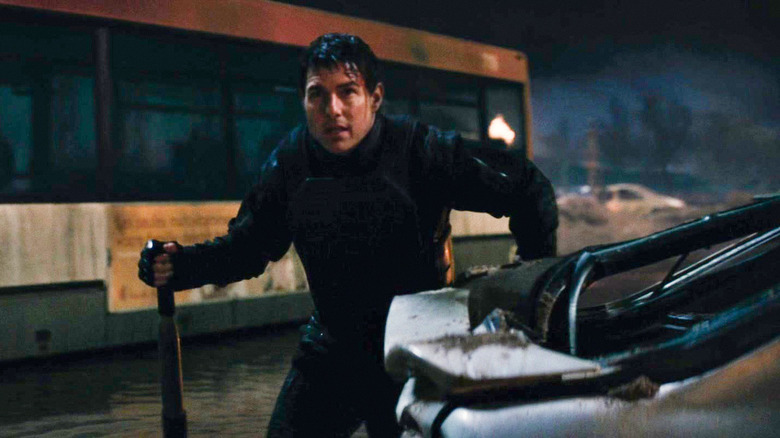Deleted Edge Of Tomorrow Scenes You've Got To See
Part of the reason so many people are avid physical media collectors is because of the special features. It's only natural to be interested in how the films you love were made, and to desire to learn more about the production. Within that group are people who just want more of the movie itself, so they patiently wait for extended cuts and pore over the deleted scenes to see the movie that could've been, rather than the one they got.
As the Blu-ray and DVD market has shrunk over the years, the quality and quantity of those special features have dwindled dramatically. Audio commentaries are now a rarity and behind-the-scenes featurettes amount to little more than surface level interviews with the primary cast and director that may not even run into double digit minutes in length. Extended cuts are often desired, but they rarely come to fruition. Even deleted scenes have become something of a once-in-a-blue-moon addition.
So, when we do get deleted scenes, they are worth spending time ruminating on. These few minutes of excised material may feature thrilling action, hilarious gags, or plot information that the filmmakers ultimately decided didn't need to be in the final film. Many people assume that if they love a movie that they will love it even more if there was even more in it, but that isn't necessarily the case. An interesting case study is Doug Liman's 2014 bravura science-fiction picture "Edge of Tomorrow." The Blu-ray features seven deleted scenes that run for about seven and half minutes total. Nothing about these half-dozen scenes is bad, per se, but each in their own way show themselves to be inessential or redundant. They're fun to watch on their own, but their removal makes for a better film in the end.
Out of his depth
The clever set-up of "Edge of Tomorrow" is that Tom Cruise begins the story as a character whom we expect to be like Maverick from "Top Gun" — the ultimate hot shot. In reality, all Major William Cage can do is be a pretty, confident face on television as a spokesperson for the military. He has no abilities in combat, and he especially doesn't know what he's doing operating a big mech suit meant to kill aliens. Before he goes on his first mission, the other members of the troop he has been forced into impart to him no knowledge of what he's about to get into and resent his ignorance and his very presence.
When suiting up for the first time, Cage doesn't even know where the safety for his weapon is. The original scene ends on that line, cutting straight over to the introduction of Emily Blunt's Sergeant Rita Vrataski. In the deleted footage, however, that scene continues to further show Cade's ineptitude with the suit, as he fails to detach the suit from a tether that nearly breaks the hanger the suits are housed in.
While a pretty funny moment, all it really does is take to a physical extreme the extent of his cluelessness, which is something we were already fully aware of. It slows down the pacing to take time to put a hat on a hat at a time when we are itching to go to the battlefield with the aliens for the first time. Cruise conveys the character's panic and unease with combat so effectively that this extended gag becomes superfluous. A fine, funny scene on its own but a judicious cut from the final film.
Unfinished effects and pre-vis
The first deleted scene looked as if it were fairly close to making the final film, as the color grading matches what ended up in the final film. This next deleted scene was something that was disposed of very early in the process. Not only is the scene ungraded, but it features unfinished visual effects, visible green screens, and a whole section only done in the pre-visualization phase of pre-production.
Taking place on the battlefield, we see Cruise's Major Cage attempting to warn his fellow troops that there is a Mimic (the name of the film's aliens) hiding underneath the sand on which they are fighting. We aren't given any inclination as to where in the film this particular iteration of the battle takes place, given that we return to the same battle time and time again with the repeated single day structure, but it seems to be fairly early, as Cage's handling of weaponry is still fairly amateur and his confidence in knowing what happens in the battle hasn't fully taken shape.
This is something we see quite a few times in the film, but the main attraction here is the animated pre-visualization of the end of the sequence, where Cage wakes up after being knocked out by an alien to see the full scale destruction and takeover by the Mimics before waking up once again to Bill Paxton yelling at him. Because the scene appears to place fairly early in the story, the filmmakers most likely didn't want to play their hand too soon about the extent to which this war with the Mimics could go completely sideways. We're still having fun learning the rules and mechanics to this repeated day, and having something that somber could kill that fun. Another wise cut.
The start of training
The next deleted scene is far closer to the first one in terms of carefully removing some fat and making for a stronger transition from one scene to another. After being told by Emily Blunt's Rita Vrataski to find her when he wakes up after being killed, she begins to train Cruise's Major Cage in improving his combat skills. In the final cut of the film, Cruise delivers the line, "I'm not even trained for combat," and after a brief reaction shot of Blunt, we immediately cut to him recklessly firing bullets at the mechanical training Mimics, not having a single clue to what he is doing.
However, in the deleted scene, we see Cruise's character in a more frantic state, very concerned about not being able to operate well on the battlefield at all. Then when we cut over to the first training session, we see him walk out into the training zone and do some light stretching. Rita asks, "How good are you, would you say?" His response: "Good. Pretty good. I'm a quick learner." Even if it is delivered with purposefully false confidence, the whiplash from his panicked state twenty seconds earlier to this more brash attitude is stark. Isolated, each scene works on its own, but juxtaposed with one another, they feel disconnected.
By cutting these things out, they have not just streamlined the story, but they have also maintained a tonal consistency that didn't exist in the earlier version. Again, this is the first forty-five minutes of the movie, and our two heroes have finally come together. You don't want to let up on the fun quite yet, and keeping that tone is paramount in doing that.
Unneeded mechanical logistics
Every science fiction movie has to find the right balance with what to explain about its invented world. "Edge of Tomorrow" is a sc-fi movie, but it is also a rip-roaring action flick. If it had spent time getting too bogged down in the minutiae of how this world operates, there'd be a slack in the pace that would give us time to think about things that, in the end, aren't all that important. Case in point: the mech suits.
All the soldiers in this futuristic war wear these big, clunky mech suits. When Tom Cruise doesn't know how to use one, it's funny, but when he learns to command it, the action scenes are thrilling. We do not need to know the particulars of how these suits operate, and so a scene from the film that explains how they're powered was cut. Cage and Rita make a pit stop on a drive for Cage to siphon some gas out of an abandoned car on the side of the road. The primary function of the scene is to see Rita's reaction to the desolation of this highway, which Cage has clearly become familiar with. But at the end of the scene, both of their suits start to show that they are running out of battery, and she suggests bringing more next time.
Adding in the notion that their mech suits can run out of battery power only throws in a complication that ultimately the film does not need. The entire world is at stake, and whether or not the suits will last until the end of the film comes across as a trivial complication. The possibility of the characters' failure shouldn't rest on a tech issue.
Suiting up
Leading into the film's climax, Tom Cruise and Emily Blunt's characters need some further assistance in carrying out their final plan, and so they decide to enlist the help of Major Cage's squadron. The team is skeptical about helping someone they only just met (from their perspective) in Cruise's Major Cage, but are more than willing to follow the lead of Blunt's Rita Vrataski. Out of all the deleted scenes from the film, this one was most likely the easiest to cut, and the visible green screens in the background certainly point in that direction.
What the excised material basically amounts to is a brief suiting up montage. While this works in many other action films, the suits they are suiting up with are just the same suits we've seen throughout the entire film. There's nothing new to learn or experience here. Cutting from them accepting the new mission to them starting that mission is more economical and effective storytelling. Every other deleted scene makes for any interesting watch outside of the film itself, but this is the one you can just skip entirely.
A horse, of course
The final deleted scene from "Edge of Tomorrow" comes from the film's climactic battle against the Mimics. The squad's ship to Paris has been destroyed, and Cruise's Major Cage ends up in the water, crawling out to dry land. In the final cut of the film, that's all that happens. But the footage that was cut gives Paris an eerier feeling than the already present destruction created. Cage takes time to survey the emptiness, and as he does so he encounters a lone horse galloping through the flooded street.
As is the case with so many of these edits, all this does is slow down the pacing of the film. Previous deleted scenes were cut in service of the zip and fun of the story, but here, we are in the final stretch of the film. The final showdown with the Mimics is so close. This couldn't be a worse time to decide to slow down and take in the haunting beauty of a destroyed Paris. Like the aforementioned deleted battlefield scene, this one is also filled with unfinished visual effects and is not properly color-corrected. The horse looks to be real but was shot separately and has been composited into the scene.
Very rarely are the quality of deleted scenes vastly inferior to the final film. There is nothing particularly wrong with any of these seven scenes on their own, and in other versions of "Edge of Tomorrow," they may have worked. However, films constantly evolve, from the first draft of a screenplay to the final sound mix, gradually revealing what kind of movie the filmmakers are actually making. The final version of "Edge of Tomorrow" didn't need any of these deleted scenes, and it was actually better without them. But on their own, they still offer an interesting glimpse into how the film took shape.
